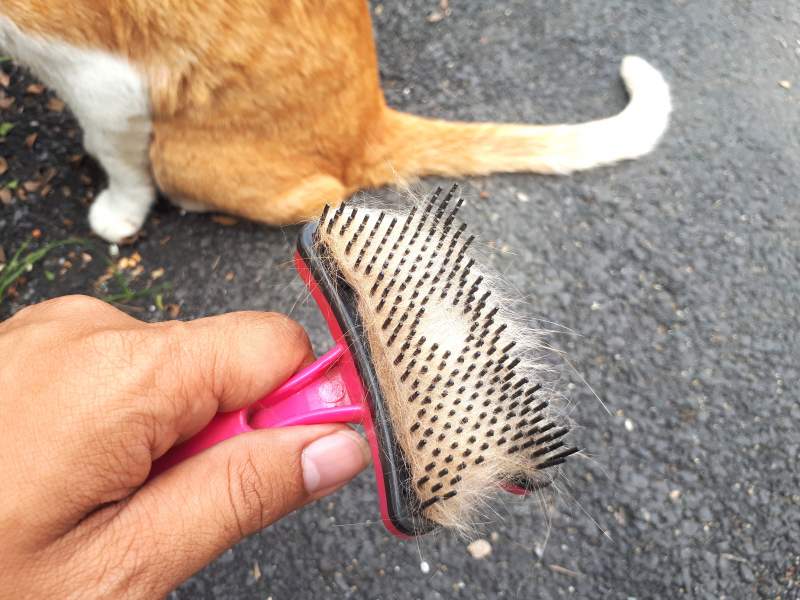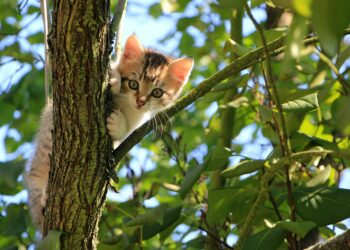A hairball is a stomach or intestinal obstruction or blockage the cats may develop occasionally. Trichobezoar, the scientific name of cat hairball, may develop due to hair swallowing.
To keep themselves clean, the cats do self-grooming, and thus they swallow some loose hair. The continuous accumulation of fur inside the intestine creates an intestinal blockage.
Most people ignore it because they consider it a seasonal issue, but that this can be fatal. You can not stop your cat from self-grooming, so how can you prevent or lessen the chances of hairballs?
Causes of Hairballs in Cat
Self Grooming
Hairballs develop in cats due to the usual habit of self-grooming.
When the cat licks her body to clean it, the tiny projections in the tongue called papillae catch the loose hair.
The hair is made up of a protein called keratin which is indigestible, so the swallowed hairs pass down from the esophagus to the stomach and are excreted from the body through feces.
Sometimes these hairs form a mass or clump in the intestine. In order to get rid of this hair mass, the feline regurgitates.
The hairball is not a rounded clump; rather, it appears like a tube.
Reading Suggestion: Hairballs in Cats: Causes, Symptoms, and Remedies
Cat Breeds
There is a high risk of hairball in some breeds of cats, like Persian and Maine coon cats, because they have a more furry body.
If you groom your cat regularly with the best cat brush, you will probably decrease the trichobezoar.
The cat who sheds a lot of hair or those who groom herself very often is prone to the development of repeated hairball.
Reading Suggestion: Best Cat Breeds for Beginners: a Comprehensive Guide to Choose
Feline Diet
Improper diet can also be the cause of more loose fur and hairballs. To avoid this disease, you should keep control of your cat’s diet.
Give your cat a mixture of dry and wet food, clean, ample water to drink, and add natural fiber and omega fatty acids to their diet.
These fiber and fatty acids reduce the development of hairballs and make your feline coat strong and healthy.
Hairball Manifestation
When the mass of fur develops in the intestine of your feline, they try to get rid of this intestinal debris by vomiting which is the marked sign of hairball.
In the vomit, they pass out particles of fur that resemble the color of your cat. The common symptom of periodic trichobezoar is gagging, hacking, retching, followed by vomiting.
The regurgitation (vomit) of a cat, once or twice a week is common, and this is not a serious issue. But if the hairy clump becomes too large to pass through the esophageal opening or lodged in the intestine, it might be fatal if not treated.
There are a few symptoms through which you can identify your cat has developed hairballs complication.
- Lethargy
- Repeated hacking, gagging, retching, and vomiting
- Loss of appetite
- Constipation
- Diarrhea
- Dry cough
- Swollen abdomen
If your feline is showing such symptoms, you need to contact the veterinarian.
Treatment And Prevention Of Cat Hairball
There is no lifelong treatment for hairball, but you can control the occurrence of the problem by adopting these preventive measures.
Regular Grooming With The Best Brush
The more you brush your cat’s coat, the less the cat swallows the fur. By the cat comb, you remove the loose hair from the coat, so the cat eventually will not swallow the hair and will not develop the disease.

If your cat has long fur, you need to brush it regularly. For the other cat breeds you can groom them once in 2 days. Grooming your cat with the soft and best brush also helps you to develop a bond with your pet.
Reading Suggestion: Groomi Comb For Dogs
Diet Control
You can help develop your cat to a healthy coat with a few loose hairs by adding fiber and omega fatty acids to the diet. Specialized cat food formulas minimize shedding and also help to remove the hairball easily through the digestive tract. Moisture content in the cat food should also be regulated to avoid shedding.
Note: before changing the cat food take expert veterinarian suggestions.
Use of Laxatone
Laxatone is a laxative. It helps to pass the hairball clump through the digestive tract. Use the preventative as per your veterinarian’s instruction.
Surgery
If the hairball becomes complicated and stuck in the intestine, the only way to remove it is surgery. Leaving the hairball to stay in the intestine of a cat for a long time leads to the death of this innocent creature.
Sometimes the veterinarian also goes for an endoscopy to remove the clump from the stomach. After surgery, you need to visit the veterinarian to follow up. The veterans will check whether your cat is responding correctly after surgery.
Diagnosis of Cat Hairballs
The veterans perform the following tests to diagnose the disease:
- Physical examination
- X-ray
- Ultrasound
- Blood test
The Bottom Line
The major cause of hairballs in cats is their self-grooming habit. If you brush your cat regularly, you can reduce the frequency of the disease.








